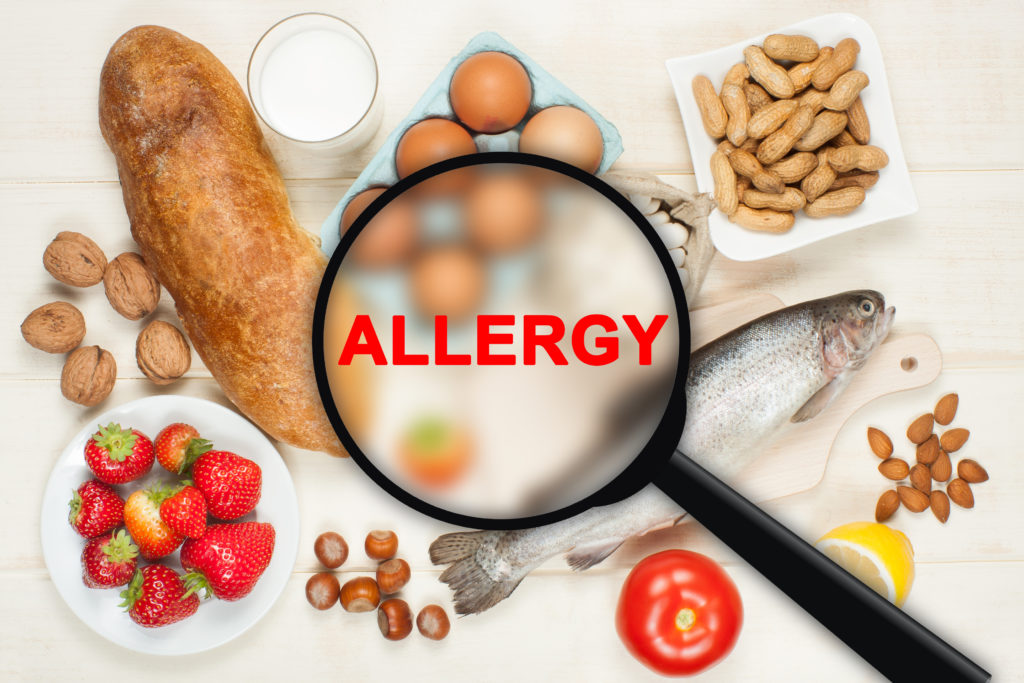Almost all foods are likely to trigger an allergic reaction. It is not easy to live with allergies and food intolerance.
Food allergies and intolerance
About one in three people say that one or a member of his family suffers from food allergies or intolerance. In reality, statistics show that only 2 to 8% of children and 1 to 2% of adults have a proven food allergy. called an allergy is often an intolerance. Allergy impairs the immune system, while intolerance originates in the gastrointestinal system and manifests itself as an inability to sediment or absorb certain substances.
Medicine has not yet explained why so many people suffer from allergies, but heredity is surely for many. Two allergic parents will more often have children allergic, although the symptoms and allergens are not necessarily the same. In children, food allergy often disappears during growth. Breastfeeding and late dietary diversification certainly reduce the risk.
The allergy evolves in stages
The first time the immune system encounters an allergen, it takes it as a dangerous invader and directs specialized cells to manufacture antibodies, immunoglobulins, to fight it. There is no allergic reaction proper on first exposure. Nevertheless, if the substance is again ingested, the antigens that are programmed to fight it will come into action at once. In some cases, the response does not cause any visible symptoms, but everything is in place for a possible antigen-antibody reaction, and therefore an allergic response.
Living with food allergies and intolerance
Once allergens identified, removing them from the diet solves the problem. But this is easier said than done because some of the most common allergens are hidden ingredients in many processed foods. Moreover, many foods have a chemical kinship. Thus, a person allergic to lemons could also be to oranges and other citrus fruits. In some cases, the real culprit contaminant or a substance accidentally found in the food.

Common symptoms of food allergies and intolerance
Food allergy can have many symptoms; Signs of allergies usually appear within minutes of absorption (up to 2 hours after).
Their nature and intensity vary from person to person. They may include any of the following symptoms, alone or in combination:
- Skin symptoms: itching, rash, redness, swelling of the lips, face, and limbs.
- Respiratory symptoms: wheezing, swelling of the throat, difficulty breathing, choking sensation.
- Digestive symptoms: abdominal cramps, diarrhea, colic, nausea, and vomiting. (If these are the only symptoms detected, it is rare that the cause is a food allergy.)
- Cardiovascular symptoms: paleness, weak pulse, dizziness, loss of consciousness.
- In severe cases, generalized edema of the skin and mucous membranes.
- Swelling of the mouth and throat may prove fatal, as it prevents air from entering the lungs.
- In extreme cases, an anaphylactic shock that paralyzes the respiratory and circulatory systems. In general, allergens always trigger the same symptoms, but their degree of intensity varies according to many factors,
Regarding the amount of food ingested, some people will handle small amounts without problems, while others will react to the slightest trace.
The Individual Host Plan (IAP)
A child allergic to a common food can not eat what is on the menu of the school cafeteria. In agreement with the school doctor, he must have an Individual Hosting Plan (IAP) which allows his parents to provide the meal he will eat at the table with his friends.
Allergy tests
In more complex cases, one or more allergy tests are used. The most common are:
- Skin Tests: Scarify the skin to allow a few amounts of various allergens to penetrate. The onset of irritation or edema at the site usually indicates an allergic reaction.
- Blood test RAST (radioallergosorbent test): A small amount of blood taken from the patient and mixed with food extracts to check for the presence of antibodies. This test recommended in patients whose skin reacts strongly to skin tests.
- Exclusion regime: It consists of eliminating the foods most often incriminated for 7 to 10 days. If, after this period, the allergy still manifests itself, it is because it originates elsewhere. Since allergy symptoms have stopped, a very small amount of the food suspected of being responsible for the allergic reaction introduced, to see if it triggers. These tests, which are not without risks, which is under close medical supervision.

Medical treatments for food allergy
Parents who suspect a food allergy in their child should tell their doctor as soon as possible. An evaluation by an allergist suggested by the doctor, who can confirm an allergy by using the tests described previously. No treatment can eliminate food allergy. The only option is to strictly ban the food (or ingredient) that causes the allergy. Some people with allergies should carry an epinephrine auto-injector at all times so that they can react quickly if an anaphylactic reaction occurs. This decision to have the auto-injector on your own, taken with the doctor.
Treatment of anaphylactic reaction
In a case of respiratory problems and significant swelling, signs indicating that an anaphylactic reaction is in motion, the only medication indicated is epinephrine, also called adrenaline. It provides rapid relief of symptoms.
Epinephrine manufactured synthetically since 1900. obtained as an injectable solution, on or without a prescription (in which case it is not reimbursed by insurance companies). Injection performed in the thigh muscle, on the outer side. In North America, there are two brands of epinephrine auto-injectors: Epipen®, which contains a single dose, and Twinject®, which contains two epinephrine auto-injectors. noted that the second dose of Twinject® is injected differently (see video demonstration in Sites of Interest). In this case, the second dose is given if symptoms worsen or do not improve. We should wait for 5 to 15 minutes before injecting the second dose. Usually, a single dose is enough.
Both auto-injector marks are available in doses of 0.15 mg and 0.3 mg. The doctor will choose the dose based on the person’s weight. Adrenaline acts quickly, but its effect is of short duration, which explains why a second dose is sometimes necessary. Note that adrenaline is a hormone that the body naturally secretes in situations of stress or fear, and during physical activity. It dilates the airways, increases cardiac pulsations, and tightens the small blood vessels that irritate the skin and digestive system. This hormone mobilizes all the resources of the body, to react quickly in an emergency.

Hidden allergens
With a food allergy, one can experience allergic reactions when eating safe foods. Why?
- Safe food has been contaminated during handling.
- Labeling, misleading, such as with the word ’emulsifier’ instead of ‘eggs’.
- Some ingredients could be replaced by others, such as peanut oil instead of rapeseed oil.
So, it is recommended to:
- Always read the composition well
- Be vigilant at the restaurant
- Do not be afraid to ask questions about the ingredients
- Avoid processed foods
- Carry self-adrenaline self-injectable in a case of emergency



